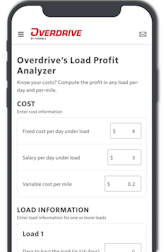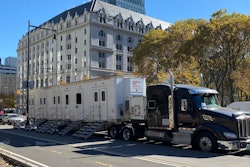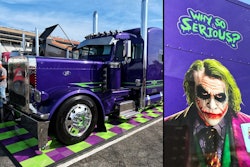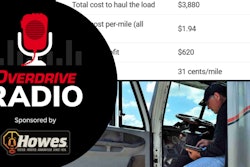The Commercial Vehicle Safety Alliance has consulted its membership from all around North America and come up with some tweaks to the out-of-service criteria for drivers and vehicles set to go into effect on April 1, 2025.
This year, the changes mostly revolve around brakes, tires, suspension components and lighting for the trucks, with only a few small changes for driver OOS conditions. Now, it's an OOS violation for a prohibited driver to accompany a driver in training and drivers without a medical certificate can no longer drive people or property in commercial vehicles. The entire North American Standard Out-of-Service criteria is available for purchase, and the changes are posted in a separate free document, here from CVSA.
Overall, the moves are minor but important. In some cases, the rules have streamlined, offering a single OOS condition where in the past many could apply. In the sections below, find everything new that could get you placed OOS.
North American Standard Driver Out-of-Service Criteria
The first OOSC update changes Part 1, Item 3 of the North American Standard OOSC "to clarify that an accompanying driver of a driver with a commercial learner’s permit (CLP) cannot be unauthorized to drive for any reason," CVSA wrote in announcing the amendment.

CVSA cited the Federal Motor Carrier Safety Administration publishing an update in the Federal Register regarding 383.25 "that stated the CLP holder must be accompanied by a valid commercial driver’s license (CDL) holder who is authorized to operate the commercial motor vehicle for that trip." Basically, if a driver is in prohibited status for some reason, perhaps failing a drug test, that driver can't accompany a CLP holder for training.
Second, Part I, Item 2, was changed "to provide clarity to the transportation of dangerous goods (TDG) certificate," which is a Canadian document for both CDL and non-CDL drivers. "The TDG regulations do not require the [hazmat and dangerous goods] classes to be listed on the training certificate. However, if they are listed, the driver is only permitted to transport the classes listed."
Third, on Part I, Item 4 on Medical Certificates will be deleted to make it clear that whether a vehicle is carrying property or people, it's the same OOS condition. "Not having a medical certificate is an imminent hazard on the first offense for a driver regardless of what type of vehicle is being driven," CVSA reasoned in making the changes.
[Related: CVSA's 2024 ouf of service criteria changes: What truckers need to know]
North American Standard Vehicle Out-of-Service Criteria
Brakes. The first change goes to Part II, Item 1, looking at brake systems (specifically electric trailer brakes), to add an OOS condition for inoperative brakes due to an unplugged electrical cable. But this change could actually result in fewer individual OOS conditions being violated, as it's a catchall for any number of inoperative brakes.
"Rather than a violation being documented for each inoperative brake, only one OOS violation will be recorded," CVSA said. "The amendment will allow for this situation to be treated the same as inoperative lamps on the rear of the trailer when there is an unplugged electrical connection resulting in one violation rather than multiple violations."
Next, another update to Part II, Item 1, makes the same change, but for air brakes. CVSA amended the "Air Brake Hose/Tubing" section to add an OOS condition for inoperative brakes due to a disconnected service gladhand. Once again, this update is a catchall for what could otherwise go down as multiple violations.
"Rather than a violation being documented for each inoperative brake, only one OOS violation will be recorded. The amendment will allow for this situation to be treated the same as inoperative lamps on the rear of the trailer when there is an unplugged electrical connection resulting in one violation rather than multiple violations."
Next, CVSA admitted sometimes it's impossible to tell what's going on with a crimped or kinked air line by modifying the "Air Brake Hose/Tubing" (5) condition under Part II, Item 1, brake systems. The modification removes "hoses and tubing that are crimped in such a manner as to restrict air flow" as OOS conditions.
"It is almost impossible during a roadside inspection to determine when an air line should be placed out of service for a restriction in air flow," CVSA wrote to explain the change. "The brake industry discussed that a crimped air line affects the brake release more than brake application." Other violations cover inoperable brakes due to bad connections and crimps that would already place the vehicle OOS. "The kinked/crimped air line is still a violation that must be repaired before the next redispatch," wrote CVSA, but due "to the subjectivity of the current language, it was removed from the OOSC."
Another change to Part II, Item 1, simply adds language to the Hydraulic Brakes section "for a brake hose or line that is marked for another application other than a brake system."
Tractor protection, securement. The next change impacts Tractor Protection Systems and now requires "both the primary and secondary system be below 20 psi rather than either system." CVSA said the "amendment was the result of a discussion with brake manufacturers who indicated that with a dual-circuit brake system, one system may remain above 20 psi and the other may fall below 20 psi; however, this should not be considered out of service as it used to be with single-circuit brake systems."
Moving on to cargo securement, Part II, Item 2: the section on General Securement added some language for the violation of 392.9(a)(2) clarifying that loose dunnage or vehicle components represent a vehicle OOS condition even though the regulations list it as a driver violation.
"The guidance in the OOSC is intended to indicate that loose dunnage, vehicle components, etc., is a vehicle OOS condition even though it is a driver violation in the regulation," the CVSA wrote.
[Related: Roadcheck 2024: Inspectors looking for drugs, alcohol and steady gladhands]
Lights. In Part II, Item 9, on lighting devices, CVSA added a section specific to projecting load lamps. "This change is necessary due to the update for lamps that are required to be on during certain times of the day. When the update was made to the title, it was intended to clarify when drivers have lights turned off on the power unit. Projecting loads are a separate issue and should be dealt with separately. Also, overhanging load lamps can operate in a variety of ways and are not necessarily switched 'on/off,' similar to headlamps and tail lamps."
Suspensions, tires. Under Part II, Item 11, on suspensions, CVSA clarified that u-bolt bottom plates "should be out of service if cracked or broken." CVSA also added a note and cleared up a diagram "to distinguish between the bolts and the bushings in spring hangers," so consult that section again if you weren't clear.
Moving on to Part II, Item 12, about tires, CVSA now says "that if only the rubber of a mudflap is contacting a tire, this should not be an OOS condition."
Another update on tires was made "to indicate that a tire without an automatic tire inflation system (ATIS) is out of service when it has a noticeable leak in the tread area." Tires with leaks in the sidewall are an OOS condition with an inflation system or not.
Finally, the tires section was amended to remove the different OOS condition for radial and bias tires and combine them into one section.
CVSA encouraged anyone with questions or in need of assistance should contact CVSA Director of Inspection Programs Kerri Wirachowsky at [email protected] or 202-998-1650.









